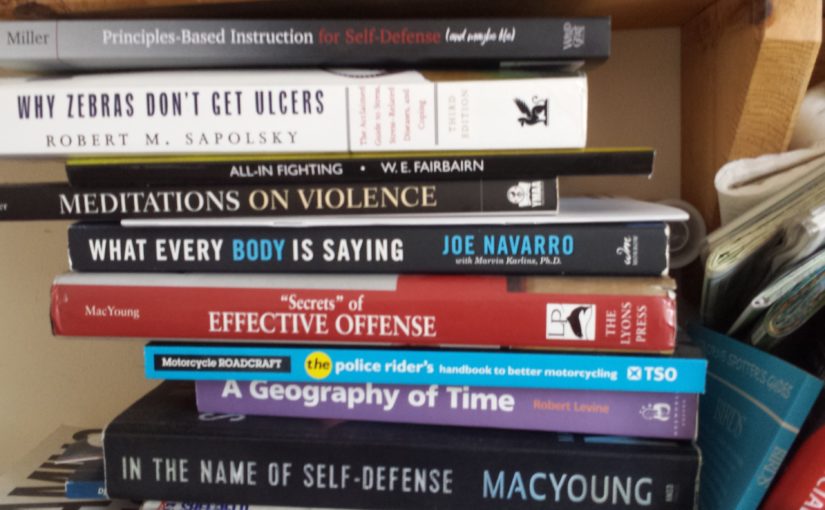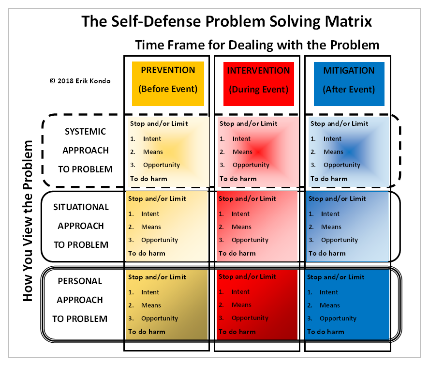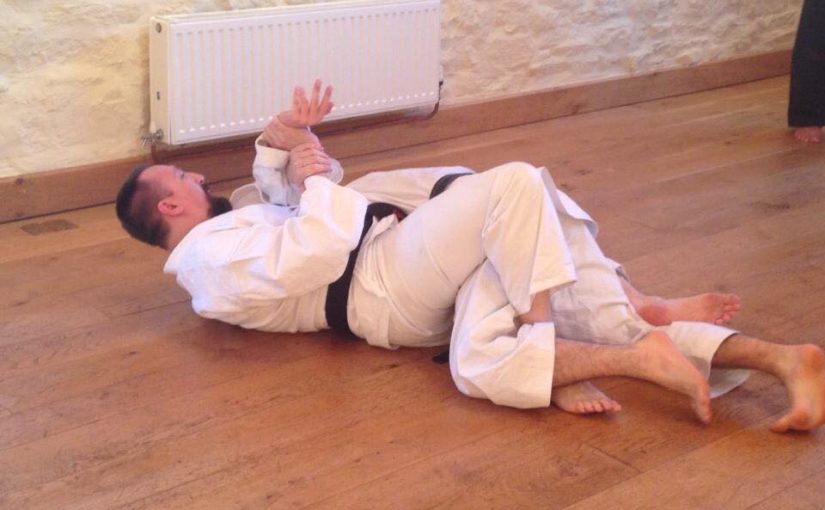As I type this, I’ve committed to the decision to cease training in Brazilian Jiujutsu after three years. The reasons for this decision are varied and unimportant, but that I’ve made a conscious decision to draw a line has given me cause to stand back and reflect on the experience.
Some background: For as long as I can remember I’ve trained in multiple martial arts, feeling that no one art has all the answers. In my youth this was solely opportunistic; I attended the clubs that opened in my small rural home town. Aged 18 I moved to university and trained in the arts that were available. Some years later I opened my own club, but I also started training at a club that opened in the venue that I trained. In recent years I’ve looked at my weaknesses or deficits in skillset and taken up arts specifically to address them. And so I came to Brazilian Jiujutsu.
In truth I’d considered BJJ in the past but I’d been put off, ironically by a member of the club that I would subsequently train at. In extolling the benefits of training in the club, he bragged that someone ends up in A&E every week with a fracture! Eventually I reached a point where I needed a challenge and wasn’t getting in the mat time as a student that I wanted. In part I probably also ran out of excuses. And so I took up BJJ.
Of course the experiences and views that I present here are mine and mine alone and are of one BJJ school. However, I’d dabbled in BJJ and grappling before and have friends in other schools. I think there will be little to disagree with here. And so I present the observations that I made. The emphasis for me and my training these days is on pragmatism and so these are the eyes I look through.
Injuries are Common
Martial arts is a contact activity. Injuries happen. I love it when Rory Miller’s pre-seminar safety talks include “hands up who here gets out of bed in the morning without their body creaking,” knowing full well that maybe one arm will go up and that’ll belong to a teenager. But in all my years of training I’ve never seen such a bunch of broken people in one changing room. Right now I suspect I have a partial tear of my left medial meniscus, my left elbow doesn’t want to fully extend, my neck goes “clunk,” my back hurts from a spine hyperextension that was supposed to be a choke, both thighs scream when I walk and my right big toe doesn’t bend due to an untreated fracture that’s become fused. And I’m a typical example!
Former UFC fighter turned Osteopath Rosi Sexton says there are only two types of grappler; those with neck injuries and those about to have neck injuries. BJJ practitioners are experts in finger-taping and joint-supports. As a pragmatist this is hardly good self-preservation.
There are Styles, but they’re called “Teams”
These days we’re used to styles – Goju Ryu, Shotokan, Wado Ryu, Kyokushinkai and so on. Conversely we don’t have ryu or kan of BJJ. Actually we do. We have Gracie Barra, Checkmat, Atos and so on. And let’s not get started on Tenth Planet!
In my view this is an interesting similarity to the classical ryu of Japan. They all expect total loyalty and a degree of secrecy. They all have their trademark techniques and tactics. They often have their own terminology too, which can be cleverly mysterious. Consider the “redneck choke,” so called because it leaves the recipient with a red neck! And let’s not get started on Tenth Planet!
In my view their expectations for devotion to their instructors goes a little too far at times.
Human Chess
The analogy of “human chess” is fair. Strategies are innumerable. Sacrifices (of position, of a grip) allow for greater victories. No experience of play is ever too much. Everyone moves in different ways. Watch for being taken from behind!
It’s Unforgiving
Right from the first class I was getting arm barred and choked. No let-up for the new guy. Most training partners won’t give a rat’s ass about your injuries. No gradual build-up to account for fitness. This isn’t wholly a bad thing. It teaches sheer determination and relentlessness. Where it is a bad thing is the number of students that fall quickly. And also how hard it is to train through injuries. I nearly quit early on. What kept me going was just sheer bloody-mindedness. I’m a black belt. I’m not going to quit!
Politics
Creonte. It’s a Brazilian Jiujutsu term for someone who has left a team and gone elsewhere. It can be likened to “traitor.” Early into training in BJJ I hosted a former UFC fighter in my dojo. That person happens to be a BJJ brown belt with another team. I’ve known them for years. I only latterly discovered that as I’d advertised the seminar as a “grappling” seminar, it was fine but if I’d advertised it as a BJJ seminar then I’d likely have found myself unwelcome in my team!
Knuckleheads
I think this is an American term but here it applies. It’s so frustrating. We know that size, weight and strength are significant advantages. That’s why there are weight classes. It takes significant skill to overcome that advantage. Add to that a lack of control of weight and you have someone frustratingly difficult to fight and that’s potentially quite dangerous.
So what do you do about it? Tell the instructor that you think they could be the cause of injuries? Hell, no. That makes you look weak or whiney. No, you protect yourself, learn how to defend to minimise injury risk. Someone will rise to the challenge of fighting the knucklehead. If you can beat them you can beat anyone. Some will do their best to avoid fighting the knucklehead as it’s just not worth it (see injuries are common.)
However, I am left with the confidence that I now have the skills in the domain of ground fighting to better an unskilled attacker bigger than I. Leaving aside all of the variables associated with real-life self protection such as weapons, multiple attackers and so on, if I can fight the heavier knucklehead, then I should fear no one.
Pragmatism
I took up BJJ to learn new skills and address a hole in my game. I knew it was 90% sport and accepted that. Helio Gracie always intended BJJ to be a method of self-defence. YouTube shows us Rener and Ryron Gracie’s work on making BJJ applicable for civilian self-defence and for Police.
In three years I didn’t do ANY BJJ that wasn’t entirely sport-orientated. Not one lesson. Not even a nod towards it. Nothing. It would seem that this is normal. And I’m left frustrated, wanting more from my three-years training.
Time Outs
You can’t afford to take time out of training. With even just a few weeks off, your training partners will have become vastly better. Sure we get a little rusty with some time away from the dojo but in BJJ the effect is magnified.
It’s Demoralising
We have great sessions where everything goes well. That baiting to set up the submission that we’ve been working on goes amazingly well. We flow. No-one can touch us. We’re the hammer.
Then the next lesson we’re the anvil. The newbie nearly submits us. We get the knucklehead. Nothing works.
Another scenario is that we’re up against a higher grade with “slick” transitions. They just seem to do nothing with any effort but they negate everything we have with ease. Their Jiujutsu is to be admired, but we just wish they weren’t so good.
“Grading” is a Dirty Word
Grades / grading / belts / promotions. Don’t talk about it. Just “trust the process.” Well after three years my conclusion is that actually I don’t trust the process. The process involves unquestioning devotion to the instructor (see There are styles…) and no idea of what you’re actually supposed to be learning or what your standard is.
Personally I like clearly defined objectives, be it a coursework deadline, a competition, a project or a grading. But we mustn’t ever say that. Oh no. A lot of students of BJJ are very happy with this and that’s great. A lot actually come to BJJ because they don’t like the traditional approach of regular grading.
But if you ask your instructor, your professor, about it, then expect to go down in their estimation. Even asking what you should work on in order to earn promotion will likely give you the raised eyebrows.
You Don’t Know What You Know
In any other art I could clearly state the kata that I’ve learned and been graded on. I could list the throws that I knew and been graded on. I could list drills that I’d practiced. I knew what I knew. On leaving BJJ it feels like I know nothing.
This clearly isn’t true. In various times of practice I’ve found myself pulling off techniques only learned in the BJJ dojo. In pragmatic free drills where I’ve found myself on the floor I’ve suddenly discovered that actually I did learn the double-leg x-guard sweep and can effectively execute it to bring my attacker down and also get to my feet. It’s just there’s no published syllabus or specific measured objectives.
It’s Rewarding
Interestingly, much of my observation has been negative but those comments can be seen very positively too. Physically, it provides an incredibly good workout. Psychologically, the difficulty in finding success means success gives a greater high. Socially, the team belonging can be a great moral boost. For all of the issues that I’ve cited I actually do miss training for the reasons I give here.
They Don’t (Typically) Respect the Concept of Pragmatism
I ruffled quite a few feathers over this. Several members of my club believed beyond doubt that BJJ was the only real martial art of value and it was undeniably the best for self-protection. I never doubted the benefits of it. Physical fitness, determination, technique, live practice and solid principles were massively beneficial. However when I cited realities of violence such as weapons, multiple attackers, furnished surroundings, surprise attacks and so on I just met a barrier of denial and insults. When I suggested that rather than learning BJJ to defend yourself from the clichéd dark-alley attack, the student may be better off avoiding the dark alley, I might as well have grown a second head such was how radical my thinking was.
I know, there is much good pragmatic BJJ work out there. Sadly I’m yet to encounter it.
One prominent BJJ practitioner advised me that in their view the best art for physical self-protection was rugby. They have a good point and I admire their open-mindedness and honesty.
So, what conclusion can I draw from all of this? BJJ was something I came to both love and hate. Dragging myself to the club was always hard and took immense discipline. I got injured. My wife hated me doing it. And yet I miss it. There is no doubt that I got a lot from it, although probably not what I was expecting or seeking. Currently I’m starting to appreciate how BJJ fits into my own Jujitsu (note the spelling difference) syllabus and objectives. I’m finding the value but it’s taking lot of filtering to gather the bits that I want and can use. Is there value in the pragmatist learning BJJ? Well yes, but look closely at what the club offers. Be selective. Keep my words in mind.
I hope these observations are of interest to the prospective Jiujitero and I can imagine the BJJ veteran reading this and nodding with a wry smile.





